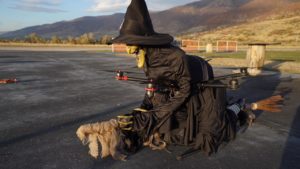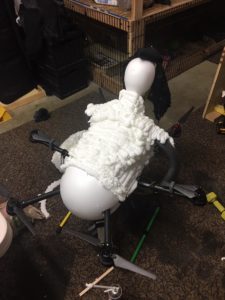 Guest Post: Kara Murphy is a Part 107 certified drone pilot and frequent guest writer for leading drone publications.
Guest Post: Kara Murphy is a Part 107 certified drone pilot and frequent guest writer for leading drone publications.
Last week, while browsing my favorite drone-related Facebook group, Drone Pilot Profits, I was instantly awestruck with a video my friend, Jon McBride, posted. Aptly titled The Flying Witch’s Revenge, it showcases Halloween’s most notorious ghoul riding her broomstick while chasing a hapless fellow across a field. The realistic portrayal motivated me to reach out to Jon and ask about his process. He, in turn, put me in touch with the Flying Witch’s mastermind, Mark Cawley. Read on to discover how he came up with the idea and executed it after a few years of trial-and-error.
Jon and Mark met at a hobby shop, in 2012, and established a quick friendship around their shared interest in emerging drone tech. At the time, the DJI Phantom 1 and Flamewheel 450/550 airframes were quite new. Mark discovered he enjoyed the Flamewheel series because it allowed him to customize the drone to a specific type of application. Being a huge fan of Halloween, he decided to build something based on the 550 platform two years later. At the time, people were simply suspending objects from their drones. He wanted to construct something around the actual drone.
 He purchased a decorative witch from a local Halloween store, began to disassemble her, and tinker with ways to rebuild her around the platform. Using sculpted foam objects found at Michaels, a popular chain of craft stores, along with hot glue, zip ties, safety pins, a broom stick, and outfit, he was able to customize his witch to fit around the drone’s frame. The real complexity of the whole process? Figuring out how to build something that hasn’t been created before, while managing to keep it lightweight/balanced, and out of the path of six spinning props.
He purchased a decorative witch from a local Halloween store, began to disassemble her, and tinker with ways to rebuild her around the platform. Using sculpted foam objects found at Michaels, a popular chain of craft stores, along with hot glue, zip ties, safety pins, a broom stick, and outfit, he was able to customize his witch to fit around the drone’s frame. The real complexity of the whole process? Figuring out how to build something that hasn’t been created before, while managing to keep it lightweight/balanced, and out of the path of six spinning props.
Mark needed to extend the arms of the 550 frame to give the witch more space. The motors were upgraded to allow for higher payload, and safety pins helped to keep loose fabric buttoned up. With several test flights and ensuing adjustments to gain values on the Naza V2, he perfected his flyable witch. “I will say that this first creation was a handful to fly and even the slightest breeze would cause oscillations and a tendency to weathervane. I still considered the creation a success as she was featured on the local news station and found popularity wherever she was flown.”
Because of his concerns regarding safety and flying an object of such magnitude around crowds of people, he took a break from the idea and focused on ground based spiders.
Earlier this year, while working on improved spider designs, his wife inquired about the flying witch. The Flamewheel 550 had long since been sold and replaced with more modern Inspire/S900 platforms. His DJI S900 with an A2 controller and Lightbridge had been sitting in a closet for the last year, gathering dust. With this improved technology, he was ready to work on something bigger and better.
“I’ve found that bottles of Locktite Gap Filling Foam are my medium of choice. By taking inanimate objects and wrapping them in Reynolds Wrap or Parchment Paper I’m able to spray the foam to create my own shapes. After the foam is allowed to dry/cure, I use a sharp razor blade and automotive toothed body file to cut away and shape the foam to my liking. The foam has great strength and at the same time is very lightweight.” Mark’s last point is imperative. Drones are limited in the payloads they can carry, the purpose is to make the object as light as possible.
The body of the witch is comprised of two parts — the upper half that is the head, torso, arms and the lower half that is her legs and broom stick. Cavities had to be cleared out in her upper body to allow enough prop clearance while ensuring unobstructed airflow. After reducing weight by removing excess foam, unnecessary equipment, and using lighter fabrics, he was able to get the witch down to the recommended maximum weight. She flies flawlessly, is maneuverable, and has no bad tendencies as long as wind speeds don’t exceed 5-10 knots.
As someone who tried, and is still tinkering with my own version of a ghost drone, I will say this “How To” should be an inspiration to start tinkering. There is a good deal of trial and error involved. And, if you’re around the Bountiful, Utah, area tonight, keep your eyes on the sky. Happy Halloween!
 Kara Murphy is a Part 107-certified remote pilot and writer based in the Midwest. Follow her on Instagram for her more artistic aerial imagery, find out how to hire her here.
Kara Murphy is a Part 107-certified remote pilot and writer based in the Midwest. Follow her on Instagram for her more artistic aerial imagery, find out how to hire her here.

Miriam McNabb is the Editor-in-Chief of DRONELIFE and CEO of JobForDrones, a professional drone services marketplace, and a fascinated observer of the emerging drone industry and the regulatory environment for drones. Miriam has penned over 3,000 articles focused on the commercial drone space and is an international speaker and recognized figure in the industry. Miriam has a degree from the University of Chicago and over 20 years of experience in high tech sales and marketing for new technologies.
For drone industry consulting or writing, Email Miriam.
TWITTER:@spaldingbarker
Subscribe to DroneLife here.







[…] Guest Post: Kara Murphy is a Part 107 certified drone pilot and frequent guest writer for leading drone publications. Last week, while browsing my favorite drone-related Facebook group, Drone Pilot Profits, I was instantly awestruck with a video my friend, Jon McBride, posted. Aptly titled The Flying Witch’s Revenge, it showcases Halloween’s most notorious ghoul […] The post Don’t Look Up: How to Create a Flying Fright with Your Drone appeared first on DRONELIFE. See Original Article […]